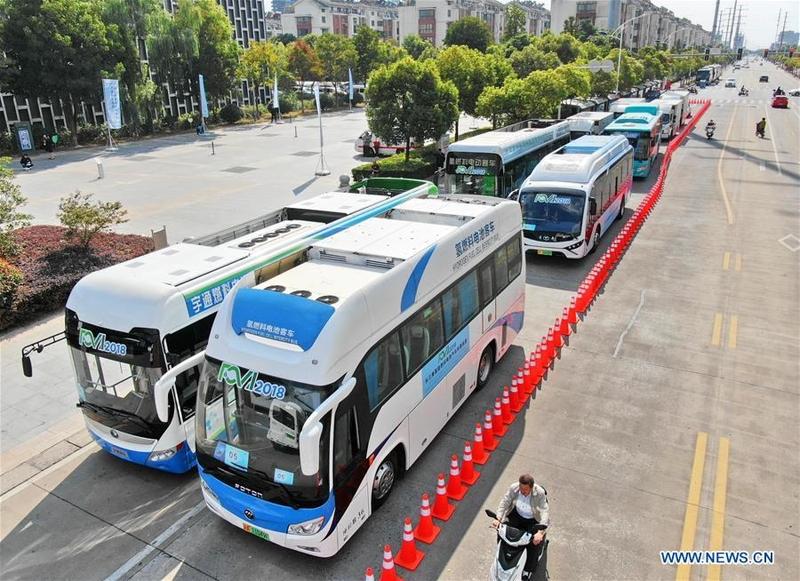 Hydrogen fuel cell vehicles are displayed during an exhibition in Rugao, east China's Jiangsu province, Oct 12, 2018. (XU CONGJUN / XINHUA)
Hydrogen fuel cell vehicles are displayed during an exhibition in Rugao, east China's Jiangsu province, Oct 12, 2018. (XU CONGJUN / XINHUA)
China has been actively developing hydrogen energy in recent years as the country sees it as the key to slowing climate change.
In my understanding, however, there is more to hydrogen than just its importance in reducing carbon emissions. What makes the clean fuel more important is that it will also help ensure the country's energy security in the long term as China has been heavily dependent on oil and gas imports in recent years.
Hydrogen is attractive as it can be produced from many resources, including fossil fuel, wind, or even sunlight. China included the development of hydrogen stations for new energy vehicles for the first time in its Government Work Report in 2019, a symbol of the government's faith in the future of hydrogen as well as a government endorsement of the hydrogen energy economy.
There is no doubt hydrogen energy economy is expected to accelerate in China, given all the policy support and enthusiasm from the companies. According to Guolian Securities, hydrogen will account for 10 percent in China's energy mix by 2050, with demand for hydrogen expected to reach 60 million metric tons. China is expected to see 10,000 hydrogen refueling stations by then, it said.
China included the development of hydrogen stations for new energy vehicles for the first time in its Government Work Report in 2019, a symbol of the government's faith in the future of hydrogen as well as a government endorsement of the hydrogen energy economy
China's current situation reminds me of the neighboring Japan, which boasts the largest network of hydrogen filling stations in the world, with 135 stations, all heavily subsidized.
Japan has been investing heavily in hydrogen as part of its green energy initiative, known as the Sunshine Project, and in the promotion and subsidizing of purchases of hydrogen fuel cell vehicles, and for setting up hydrogen stations.
China, too, has realized the importance of the clean fuel and is stepping up efforts to diversify the energy source.
ALSO READ: Steady shale gas bolsters China's clean energy
According to a white paper titled Energy in China's New Era, published by the State Council Information Office, the development of industrial chains in the production, storage, transport and application of green hydrogen, hydrogen-fuel cells, and hydrogen-powered vehicles, has picked up pace in China.
This is especially important as China is dependent on crude oil and gas imports now more than ever, with import dependency rate for crude oil seen exceeding 73 percent during the 2021-25 period and that for natural gas expected to reach 50 percent.
BloombergNEF data show China's gas dependency rate reached 42 percent in 2019. Its dependency on oil imports rose to 73 percent in 2019, compared with 71 percent in 2018, 69 percent in 2017 and 66 percent in 2016.
However, most of the new hydrogen generation facilities announced in the country are based on coal gasification, known as gray hydrogen. As a result, vehicles using hydrogen made by this process release more carbon dioxide compared with those burning gasoline.
The key difference between gray, blue and green hydrogen is that gray hydrogen is the hydrogen gas produced using fossil fuels, and blue hydrogen is the hydrogen gas that is produced using nonrenewable energy whereas green hydrogen is hydrogen gas that is produced using renewable energy. For hydrogen to have net environmental benefits, we should look for those produced from renewable power instead of fossil fuels.
READ MORE: Bosch's Wuxi hydrogen fuel cell plant set to enhance local R&D


